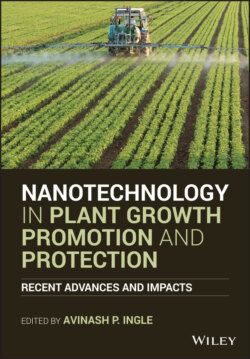Читать книгу Nanotechnology in Plant Growth Promotion and Protection - Группа авторов - Страница 40
2.3.4 Interaction of TiO2NPs with Plants
ОглавлениеTiO2NPs are considered to be plant‐growth stimulants (Liu and Lal 2015; Faraz et al. 2020; Kolenčík et al. 2020; Sun et al. 2020). The response of plants to these nanoparticles occurs on many levels. Physiologically, it was observed both positive and negative response in growth parameters like root and shoot length, dry and fresh weight, the content of chlorophylls, gluten and starch, and seed production (Zheng et al. 2005; Asli and Neumann 2009; Ruffini Castiglione et al. 2011; Larue et al. 2012b; Jaberzadeh et al. 2013; Raliya et al. 2015a,b).
Leaf growth and transpiration may be affected via physical effects such as clogging which hinder root water transport (Asli and Neumann 2009) although there are few studies demonstrating that TiO2NPs promote water uptake (Zheng et al. 2005; Clément et al. 2013; Jaberzadeh et al. 2013). Promotion of root growth may therefore happen not only because of the improved conditions by TiO2NPs but also as an avoidance mechanism arising from the stress caused by nanoparticles (Barrena et al. 2009; Feizi et al. 2013b).
Treatment with TiO2NPs was shown to protect chloroplasts from aging with prolonged stability of chloroplast under illumination. Suggested mechanisms involve a significant increase in catalase, peroxidase, and superoxide dismutase, a decrease in the concentration of reactive oxygen species and the content of malondialdehyde. Moreover, at the molecular level, the reduction rate of ferricyanide, the rate of oxygen evolution in chloroplasts, and the rate of noncyclic photophosphorylation activity of chloroplasts were found to be higher. In addition, treatment with TiO2NPs also showed improvements in chloroplast coupling, and activities of Mg2+‐ATPase and chloroplast coupling factor I (CF1)‐ATPase on the thylakoid membranes (Hong et al. 2005). Similarly, the overall increase in chlorophyll concentration was also observed (Servin et al. 2013; Raliya et al. 2015a).
However, the application of TiO2NPs at high concentrations was found to be toxic. The decreased growth was accompanied by a lowered mitotic index, increase in reactive oxygen species, antioxidant activity, and genotoxicity (Rafique et al. 2015). In microalgae, the genotoxicity is connected with the absence of an intact nucleus (Dalai et al. 2013). Ghosh et al. (2010) simply reported DNA damage in N. tabacum.
TiO2NPs also affect the uptake and homeostasis of essential elements. It was proposed that the accumulation of essential elements like Cu and Fe was significantly higher under influence of pristine TiO2NPs (Tan et al. 2017). Kužel et al. (2003) reported a similar effect on homeostasis in plants grown with dissolved Ti4+ citrate. The proposed mechanism involved suggested that Ti causes apparent Fe deficiency resulting in upregulation of transport of divalent ions and accumulation of Fe, Zn, and possibly also Cu. A higher conversion of inorganic nitrogen to its organic form was observed in spinach (Yang et al. 2006) and a higher accumulation of K and P was also observed in cucumber treated with TiO2NPs (Servin et al. 2013).
